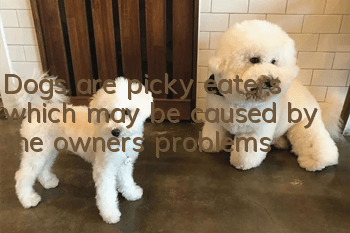Dogs are picky eaters, which may be caused by the owner’s problems

Nowadays, as the dog breeding brigade gradually grows, in order to provide more pampering for our dogs, manufacturers seem to have seen business opportunities. Various types of dog food, canned dogs, beef jerky, biscuits and other pet foods are emerging in endlessly. Some parents are not satisfied with this and start feeding human food, adding diversity to the dog's knowledge of food. Then this question was extended:
In fact, most parents don’t pay so much attention to the problem of picky eaters in dogs. Usually, they feed their dogs whatever they want to eat to cater to their tastes. They even go so far as to express their love for their dogs by holding them in their arms, coaxing them, feeding them, and following them around. Chase and feed from behind. However, in the long run, it will cause physical discomfort to the dog and cause various problems.
Physical diseases caused by picky eating:
1. Whole meat syndrome
2. Malnutrition
3. Oral diseases
4. Bone lesions
5. Hidden diseases of internal organs
6. Metabolic abnormalities
7. Skin diseases
Note: Whole-meat syndrome is caused by long-term feeding of meat products. Symptoms include acute hemorrhagic enteritis, vomiting, dysentery and other severe dehydration symptoms, which can even lead to death.
The above symptoms are the most common in dogs that are picky eaters for a long time. In addition, if you find that your dog’s hair is not as shiny as usual and frizzy and dull, then you need to be vigilant, adjust your dog’s diet, and establish The right way to eat.
The reasons why dogs are picky eaters:
1. Human reasons
• Irregular eating habits
Feeding is not scheduled, but at least one meal a day
• Feeding too many types
Excessive supplementary foods such as biscuits, beef jerky, chicken breasts, etc., or even feeding them human food, leading to increased selectivity/diarrhea
• Food Surplus
Lack of exercise, less exercise than intake leads to excess food/excessive intake of complementary foods, which increases the feeling of fullness and makes it impossible to distinguish complementary foods from staple foods
•Easy to get food
Leaving food for a long time and waiting for the dog to finish it before taking it away will cause the dog to lose interest in getting food
2. Pathological causes
·Oral diseases
Gum swelling and pain, oral ulcersOr wounds, etc., will directly affect the dog’s eating
· Gastric ulcer
Causes the dog to eat slowly and reduces the dog’s appetite
· Low thyroid secretion
Reduce dog metabolism, reduce appetite, lethargy, obesity, dry hair, etc.
· Stress response
Dogs suffer from loss of appetite after long-distance transportation, changing residences, owners, temporary foster care, etc.
3. Physiological reasons
· Estrus
· Season/Climate
The above situations can be used as the basis for parents to make their own judgments, but it does not rule out that too many preservatives are added to the staple food, dogs are born with a lack of interest in food (especially small dogs or breeds that have been fed in captivity for generations) and strong territorial awareness ( Mainly for families with more than 2 dogs) and other problems. If you encounter an uncertain situation, please seek help from a veterinarian in time. In addition, be sure to keep the water source sufficient and clean.
Aside from pathological and physiological reasons, as a parent, after confirming the reasons why dogs are picky eaters, how can we help them establish correct dietary norms?
Establish correct dietary norms:
1. Help dogs distinguish between human food and dog food
Do not feed food (bones, meat slices, etc.) from your own bowl/basin to the dog, as this will cause the dog to associate human food with dog food
2. Feed at fixed points, at least one meal a day
Two to three meals a day. When the dog matures (usually around six months), the feeding frequency can be appropriately reduced and the food intake gradually increased. Do not keep the food for more than 30 minutes (generally 10-15 minutes is most appropriate). If the dog still hasn’t eaten at the end of the meal, take it away immediately and repeat the process at the next meal time
3. Do not feed complementary foods as staple foods
· If supplementary food is mixed with dog food on a daily basis, the amount of supplementary food should be gradually reduced
· Let the dog distinguish between complementary food and staple food, and only give it during training or reward
4. Increase exercise and increase hunger
Excessive exercise will stimulate the dog to explore the outside world, consume more energy, and increase appetite
5. Use educational toys to promote eating
An educational toy similar to a "leaky ball", which allows dogs to obtain food through play and increase their interest in food
During the process, if you live with your family, you must communicate in advance about the implementation of the "dog diet adjustment plan". If you strictly follow the plan, your family will secretly "help" the dog because of distress, pity, etc. , that can only end in failure.
When dog food is first produced, it is to meet the three basic conditions required for the dog’s life, growth, development and health. And each type of dog food is designed to be convenient for parents to feed, and has the advantages of balanced nutrition, improved immunity, etc., and these all remind us that dogs and humans have different nutritional needs. Therefore, we cannot choose food based on human nutritional needs. Perhaps we think it is "love", but in fact it is "harm" that we do not want to see.
- How old is Teddy before he can take a bath? Do you know?
- Can Teddy dogs drink goat milk that humans drink?
- Things to note when bathing your dog. Learn how to bathe your dog correctly!
- How should I raise a Husky puppy when it is one month old?
- Border Collie Price | Training | Introduction
- How big should Teddy be vaccinated?
- What will happen if puppies eat adult dog food?
- How to treat fungal skin diseases in dogs?
- What should I do if my Labrador has body odor?
- How to train an English Bulldog to swim



